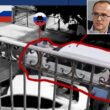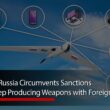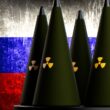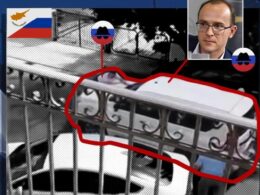Despite extensive international sanctions, Russia continues to manufacture weapons using foreign components, including microchips, semiconductors, and other microelectronics from China, the US, and the EU. These parts have been found in drones and missiles launched at Ukraine, highlighting the challenges in enforcing sanctions effectively.
During the first two weeks of September, Russia launched over 640 Shahed drones at Ukrainian cities, according to President Volodymyr Zelenskyy. Moscow shows no signs of depleting its stock, as foreign-made components are still being discovered in Russian weaponry targeting Ukraine.
Vladyslav Vlasiuk, Zelenskyy’s advisor and commissioner for sanctions policy, acknowledged that while sanctions have impacted Russia’s military production, they have not entirely stopped it. “Russians are still quite able to acquire those parts and produce weapons, including missiles and drones. We are, however, pleased that they are receiving fewer parts than they need and are paying much higher prices for them,” Vlasiuk told Euronews.
David O’Sullivan, the EU sanctions envoy, provided further details: “We estimate that, for some microelectronics, costs have increased by 125%, and in some cases, up to 300%. This constitutes significant damage to Russia’s military-industrial complex.” He emphasized the importance of identifying priority battlefield products, a task undertaken by the Kyiv Scientific Research Institute of Forensic Expertise (KSRIFE).
Priority Battlefield Products and Russia’s Adaptation
Nataliia Nestor, Deputy Director of KSRIFE, noted that the institute’s experts conducted around 30,000 studies last year related to Russia’s military aggression against Ukraine. They examined almost all types of missiles used by Russia, including Iskander, Kinzhal, Kalibr, Kh-101, Kh-55, and Kh-59, as well as attack drones such as Shahed-136 and Shahed-121, and reconnaissance drones like Kartograf, Orlan-10, and Supercam.
Most components from EU countries were found in Geran-2 (Shahed-136) and Orlan drones, as well as in reconnaissance UAVs like Eleron and ZALA, and in missiles of the Iskander, Kh-101, and Kinzhal systems. “In attack drones, we typically find processors, microcircuits, switches, contact groups, sensors, diodes, chips, fuel pumps, flash memory, and more—all made in the EU,” Nestor explained to Euronews.
How Moscow Acquires These Components
Russia uses a vast global network of agents to procure these components through intermediary or third-party countries, bypassing sanctions. Many of the foreign parts are dual-use components, meaning they are originally intended for household appliances but can also be used in weapons. Some of these components, found in Russian drones and missiles, are typically used in washing machines, cameras, online networking devices, and other consumer electronics.
“Unfortunately, technologies meant to make life easier are being repurposed for military use, leading to civilian casualties,” Nestor said.
Russia has also adapted to sanctions by frequently changing the components used in its missiles and drones, making enforcement of sanctions more difficult. This adaptability indicates that while sanctions disrupt regular supply chains, they have not completely stopped Russia’s access to these parts. Nestor pointed out that the supplier could change from Switzerland one day to Germany or the Netherlands the next, indicating the decentralized nature of Russia’s procurement network. Additionally, Russia has begun producing some components domestically, ensuring that its military production will continue.
The Importance of Strengthening Sanctions
The persistence of foreign components in Russian weapons underscores the need for more stringent and targeted sanctions. While current sanctions have raised costs and disrupted supply chains, they are not enough to fully halt Russia’s war machine. To effectively limit Russia’s military capabilities and reduce civilian casualties in Ukraine, the international community must close loopholes in the sanctions regime, enhance enforcement, and increase pressure on countries and companies that enable Russia to bypass restrictions.
Only through coordinated, comprehensive, and intensified sanctions can the flow of critical components to Russia be truly curtailed, hindering its ability to wage war and forcing it to reconsider its aggressive actions against Ukraine.








